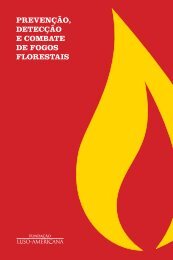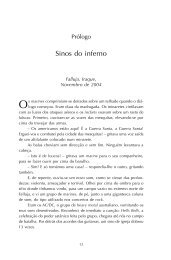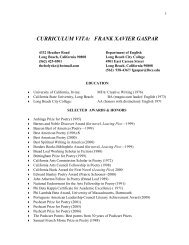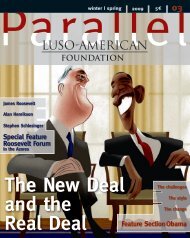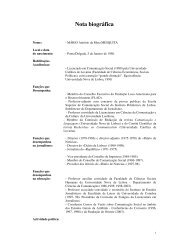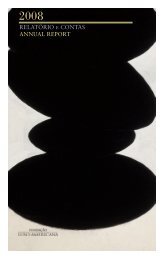A decade later - Fundação Luso-Americana
A decade later - Fundação Luso-Americana
A decade later - Fundação Luso-Americana
You also want an ePaper? Increase the reach of your titles
YUMPU automatically turns print PDFs into web optimized ePapers that Google loves.
George Steiner<br />
at The New yorker<br />
George steiner<br />
(edited and with an introduction<br />
by Robert Boyers)<br />
Gradiva, Lisbon, 2010. 1<br />
80<br />
The Horn<br />
of Plenty<br />
By cArLos Leone<br />
Though it has been bandied about, the<br />
“death of the intellectual” remains to be<br />
proved. A bit like the previously also widely-discussed<br />
“treason,” the public figure<br />
known as the “intellectual,” so typical of<br />
modernity, has persisted amid the general<br />
decline of the conditions that brought him<br />
to the fore and gave him the chance to exist.<br />
With the demise of Enlightenment optimism,<br />
the end of widespread belief in the<br />
neutrality of science, the death of literate<br />
culture of a universal bent, and at a time<br />
when even the civilizational principles that<br />
the West has taken for granted are being<br />
placed in jeopardy (e.g., human rights), the<br />
time-honored, ambiguous, polymorphic<br />
figure of the intellectual persists. It has generally<br />
been a tough row to hoe, but quite a<br />
few have become veritable darlings of the<br />
media such as Umberto Eco, Fernando<br />
Savater, Jürgen Habermas, Allan Bloom, and,<br />
cutting the list short (thus preventing some<br />
thinkers from getting their due), George<br />
Steiner. Not unexpectedly, there has been<br />
criticism that Steiner has been “over-exposed,”<br />
given the plethora of publications he<br />
has in print – many of which have been<br />
translated for distribution in smaller markets<br />
such as Portugal: from the occasional lecture<br />
(“The Idea of Europe”), to the scholarly<br />
essay (Antígones), and collections such as the<br />
one put together by Robert Boyers, which<br />
taps material that Steiner wrote during his<br />
<strong>decade</strong>s-long collaboration with America’s<br />
distinguished magazine, the New Yorker.<br />
Interestingly, the editor himself broaches the<br />
criticism that has often been leveled at<br />
BooK revieWs<br />
Steiner (and others like him): that he dabbles<br />
in fields he has no mastery of, especially<br />
when it comes to his alleged over-exposure<br />
in publishing and media circles. But when<br />
you read him, even if you are at odds with<br />
his ideas (which would not be surprising,<br />
given their striking singularity), the sensation<br />
you get is one that can be described in<br />
totally different terms: over-abundance.<br />
Steiner was born in Paris in 1929 and was<br />
educated in the United States (a fact he discusses<br />
in the book, in the final essay, which<br />
is not autobiographical). He is currently a<br />
professor in Oxbridge, literally dividing his<br />
time between Oxford and Cambridge. He<br />
‘ it seemed to exemplify<br />
nietzsche’s insight that there is<br />
in men and women a motivation<br />
stronger even than love<br />
or hatred or fear. it is that of<br />
being interested – in a body<br />
of knowledge, in a problem,<br />
in a hobby, in tomorrow’s<br />
news-paper.”<br />
steiner<br />
’ George<br />
has both studied and taught at a host of<br />
prestigious US and European universities<br />
and, in addition to the books he has published,<br />
has written for a number of distinguished<br />
English-language publications. This<br />
particular anthology of New Yorker essays is<br />
illustrative of how editorial choices can<br />
effectively be based on quality and the<br />
strengths of the readership, rather than character<br />
counts and the attempt to reduce<br />
everything to the level of the “average reader,”<br />
who, by the way, does not exist. That<br />
is why this collection is eye-opening for the<br />
Portuguese reader in that it leads one to<br />
think about what Portuguese magazine or<br />
newspaper could possibly be the source of<br />
a treasure trove like this one. The fact that<br />
there is, in Portugal, no match for the New<br />
Yorker is symptomatic of deep-seated cultural<br />
differences that go deeper than the dichotomy<br />
posed by “American speed” and<br />
“European lenteur;” that is, even if we take<br />
for granted our “Europeanness” which, judging<br />
by the Steiner’s lack of reference to<br />
Portugal and Portuguese authors, is also<br />
questionable (when he spoke at FLAD in<br />
2002 in Lisbon, he was loud and clear on<br />
his views regarding this issue). What Steiner’s<br />
unrestrained writing produces is a diversity<br />
of subject matters and a prodigality of viewpoints<br />
that go into creating an over-exposure<br />
– or over-abundance – that Steiner<br />
himself powerfully addresses when he writes<br />
about Koestler who, he states, “seemed<br />
to exemplify Nietzsche’s insight that there<br />
is in men and women a motivation stronger<br />
even than love or hatred or fear. It is that of<br />
being interested – in a body of knowledge,<br />
in a problem, in a hobby, in tomorrow’s<br />
news paper.” This partial quote from one of<br />
the best essays in the book, “La Morte<br />
d’Arthur,” not only describes Steiner at his<br />
best, but the matrix of his texts: that constantly<br />
renewed link between the philosophical,<br />
the literary, the political and the<br />
historical, always graced by a personal perspective<br />
that (as in Koestler’s case) is often<br />
anchored in the personal relationship he has<br />
with the topic of each essay.<br />
However, there are limitations to be<br />
found in most of his essays: the fact that<br />
he focuses primarily on the West and reduces<br />
the contemporary to haute culture (television<br />
and advertising are the subjects of<br />
Parallel no. 6 | FALL | WINTER 2011





